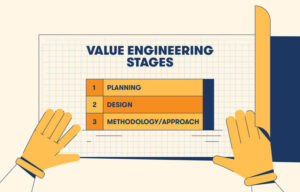
Value engineering is the systemic process of improving the value of a product by using a function by examination. In value engineering, you are looking to either reduce cost or improve the function, both of which will inevitably manipulate the value function. The same metrics described above can be used to help improve the function and bring up the value of construction by either reducing costs, improving quality etc. It plays a very vital role in the construction industry.
The steps involved in value engineering seek to efficiently optimize investments (both short and long term) and bring out the best possible value for the lowest cost.
Before we delve into the stages of value engineering, it is very important to assert the right time to value engineer. Now, technically speaking, there is no “right time” to value engineer, but it is essential to understand the value of your materials before value engineering. What you don’t want to do is rework your materials, in which case, you’re not really adding much ‘value’.
Phases of Value Engineering
During value engineering, you will come across 5 stages, each stage needs much scrutiny and should be handled carefully. Following is the value engineering methodology;
1. Information Stage
In this stage, the most important thing is to understand the purpose of the VE. Value engineering in construction involves a lot of thinking and planning, and so, a well-constructed design of the process and a presentation should be created by a design A/E.
In this process, it is also extremely important to analyze the overall VE approach, this includes scrutiny of its key functions and facilities or system governing the project. Doing so will help think about the cost aspects of the VE and also the end result given the costs.
Also Read: Different Stages of a Construction Project
2. Speculation Stage
Also known as the creative stage, this stage is the brain map of the process. It involves a listing of creative ideas that would help with the project. In this stage, the VE thinks of the various methods of reducing costs by providing necessary functions within the project. This, if successful, would improve the value of construction. Remember, never judge the ideas proposed.
This stage also looks at synonymity of ideas, which, after the approval, would be screened in the next stage of the study. Most ideas in this stage should be a direct correlation of the work done in the analysis of the function. These ideas included should be able to evaluate further the design in which it could inevitably be used.
3. Evaluation Stage
Also known as the analysis stage, this is the stage where the VE team gets in contact with the client to formulate and discuss the construction. As mentioned earlier, in this stage, the VE goes over the creative ideas brainstormed in the earlier stage with the client and evaluates the best route forward in the valuation process.
In this value engineering process, the ideas that are unworthy or are impractical are discarded, and ideas that bring down costs and greatly contribute to the value-added will be considered. It is worth mentioning that in some cases, a weighted evaluation is applied for ideas that are impactful to factors other than costs (factors such as the impact on schedule, aesthetics etc.…)
4. Development Stage
This is the stage in the value engineering process where the ideas that were taken forward in the earlier stage are tested and made into workable solutions. These include a change in the description of the design change. It also involves an elaborate and descriptive evaluation of the pros and cons of the changed recommendation.
Costs are also compared to the designs recommended with the LCC, which is then presented to compare the proposed change and the original design. And if need be, sketches and calculations of the design are also included.
5. Presentation Stage
The last part of the VE process, this is the process of creating a presentation of the recommended process of value addition in the form of a written report. This is then presented to clients and design team representatives.
The presentation must include;
- The reasoning behind the development of each proposal.
- Summary of the key cost impacts. This will then go on to solidify the backing of which value management proposal will be chosen for implementation, which will be recorded in the design documents.
- State the monetary benefits.
A VE workshop where this is presented will not only bring about key project participants to come together but will also help raise views of the chosen and proposed projects from different perspectives.
Conclusion
To conclude, value engineering is essential because it improves the functionality of the project and also improves savings tremendously. Also, when a project is re-checked by architects and engineers, it gives it a sense of assurance and guarantee of success. It also guarantees that the building will reach its best value.

